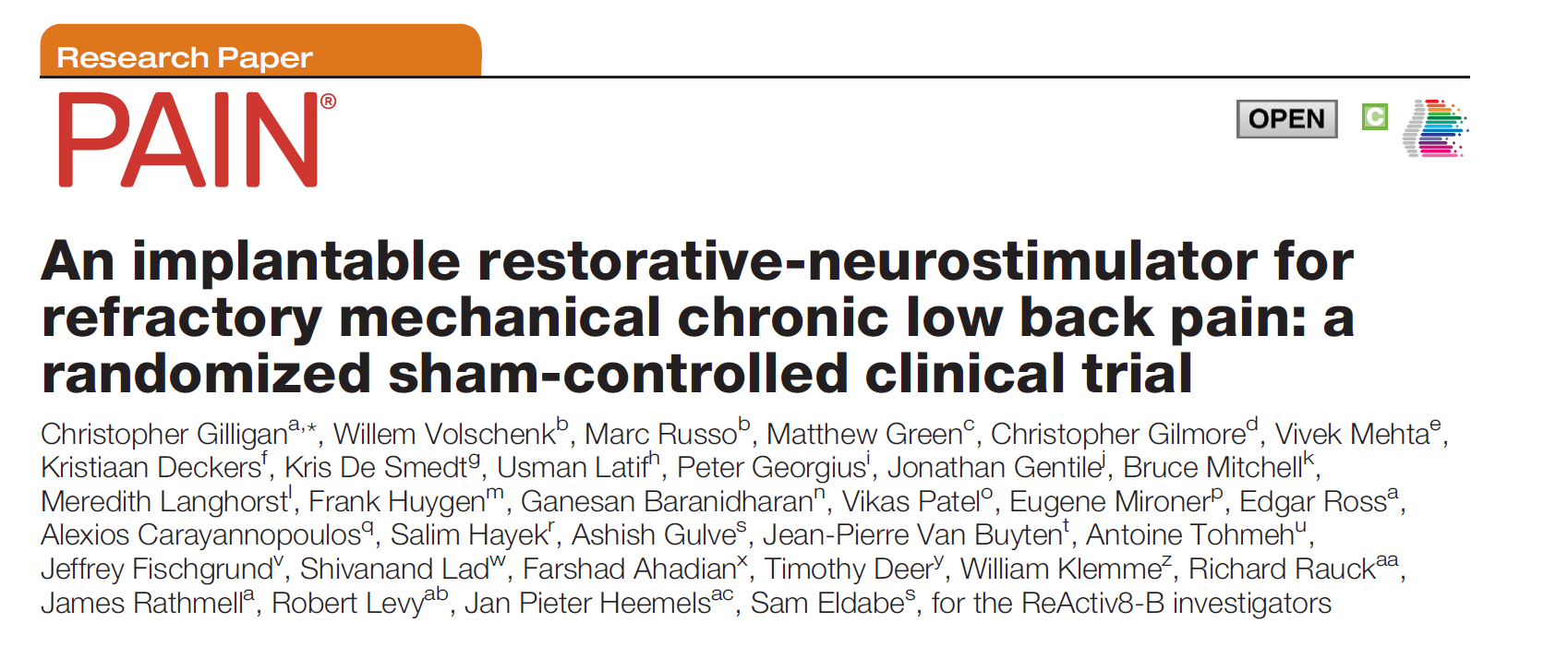Compelling Clinical Data
Collection of clinical evidence and scientific literature supporting ReActiv8 Restorative Neurostimulation
Clinical Study Publications –
First ever randomized sham-controlled research in neuromodulation
ReActiv8 – B Trial for FDA Approval
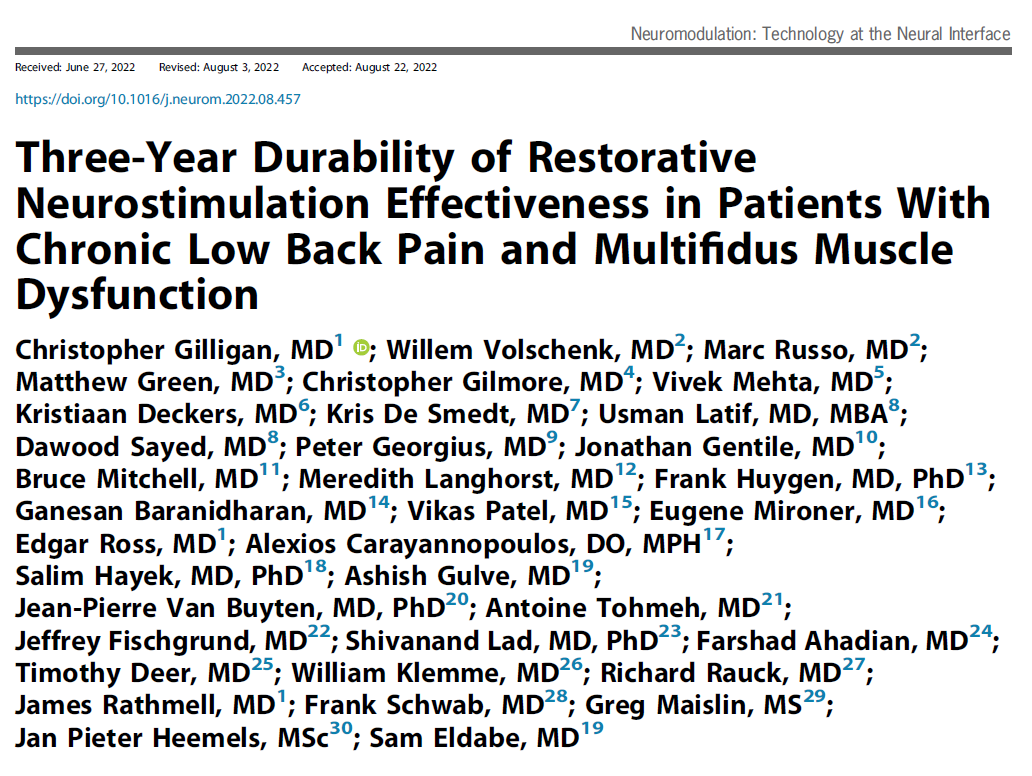
- 77% of participants had ≥50% VAS reduction
- 67% reported CLBP resolution (VAS ≤ 2.5 cm)
- 63% had a reduction in ODI of ≥20 points
- Trajectory and durability of three year clinical benefits are consistent with restoration of neuromuscular control and muscle rehabilitation.
ReActiv8 – A Trial for CE Mark
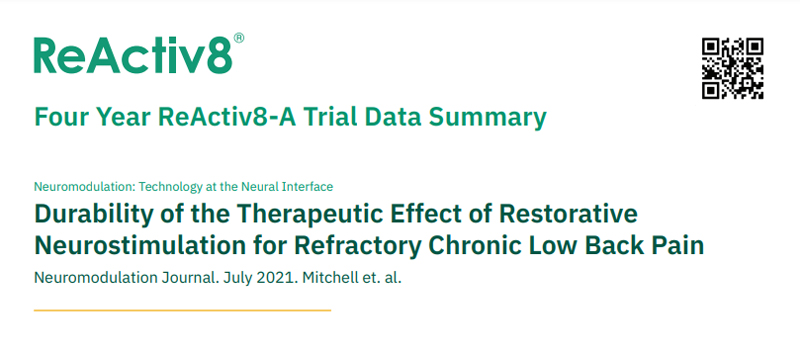
- 73% of Completers showed improvement ≥2 points on NRS
- 76% of Completers showed improvement ≥10 points on ODI
- 97% of Completers were very satisfied with treatment
- In participants with disabling intractable CLBP who receive long-term restorative neurostimulation, treatment satisfaction and results remain durable through four years.
Real World Evidence
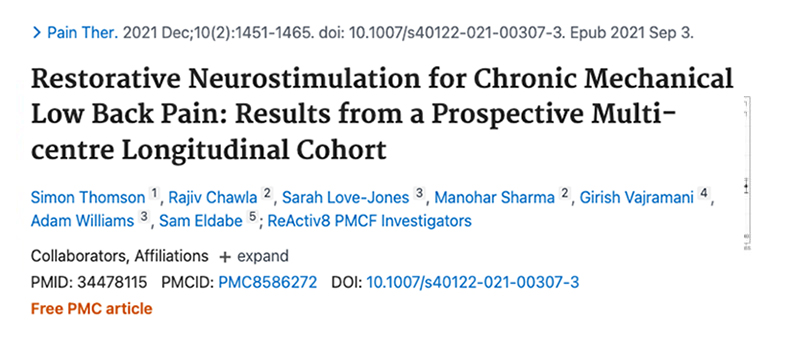
- 57% of patients experienced a substantial improvement of ≥ 50% reduction in NRS pain score
- 51% of patients experienced a substantial improvement of ≥ 15-point reduction in ODI score
- Excellent safety profile compared to similarly implanted devices
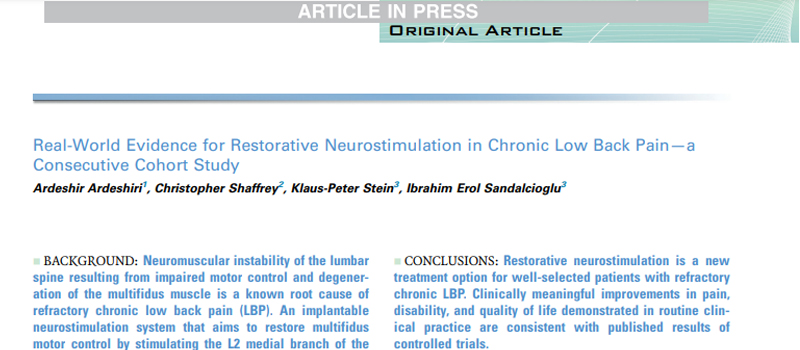
- Single surgeon, single center, real world evidence with one-year clinical follow-up
- 44 patients from the ReActiv8-C study were consecutively included into this cohort if they presented with back pain (NRS) ≥6 and no prior lumbar surgery
- 40 patients completed all required testing at the follow up visit showing statistically significant improvements in pain (NRS), disability (ODI) and quality of life (EQ-5D-5L)
- Response to ReActiv8 is durable and the benefits accumulate over time consistent with the restorative mechanism of action
- No lead migrations
- Results of this real-world experience are consistent with the published data from the earlier ReActiv8-A and ReActiv8-B studies
Restorative Neurostimulation –
Literature and scientific discussions on the importance of this new therapy

- Re-establishing control of the multifidus muscle may not be feasible with physical therapy and exercise alone.
- Direct electrical stimulation of the multifidus may be a suitable alternative for motor dysfunction.
- A combination of history, imaging, and multiple provocative maneuvers has allowed for increased accuracy in diagnosis, leading to excellent outcomes.

- Clinical instability is related to chronic low back pain.
- Altered motor control and inhibition of the multifidus is a cause of clinical instability and CLBP.
- Back pain due to disrupted muscle control is associated with neuroplastic changes in the motor cortex, which can be reversed with elimination of back pain.
- A program of biofeedback guided motor control exercise of the multifidus can restore some disrupted motor control, but traditional physiotherapy may be very difficult in the context of inhibition.
Physiologic Testing –
How to objectively identify patients with neuromotor dysfunction
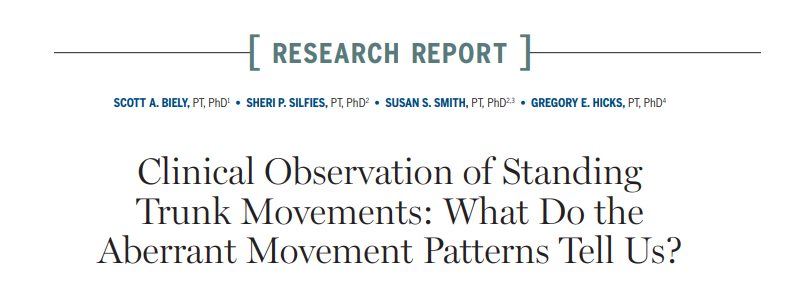
- Observation of trunk movement is considered an important part of the clinical examination of patients with low back pain (LBP).
- The presence of forward-bending movement aberrance is frequently seen in patients with acute/subacute, nonspecific LBP, compared to those without a history of LBP.
- Aberrant movements indicate that some motor control or musculoskeletal impairment remains unresolved in this group.
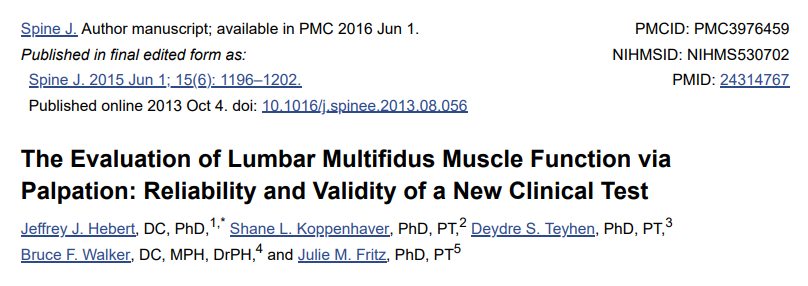
- The lumbar multifidus muscle is a critical contributor to lumbar spine stability and deficits in its function are associated with LBP.
- A physical examination method assessing multifidus function could provide great clinical utility as a diagnostic approach.
- Results provide evidence supporting the reliability and validity of the Multifidus Lift Test (MLT) to assess lumbar multifidus function.

- Clinical or functional instability consists of insufficient motor control and is a factor in abnormal inter-segmental movement and LBP, where no lumbar architecture defect can be observed on imaging.
- In the absence of imaging as a tool, reliable physical assessments are critical for proper diagnosis of functional instability.
- The prone instability test (PIT) demonstrates good reliability and moderate accuracy in diagnosing functional lumbar instability.
Role of the multifidus – how recent science has identified
this muscle as critical in preventing CLBP

- The Multifidus morphology is uniquely different from other lumbar muscles, and therefore has a special role in lumbar stability.
- Changes in the multifidus have been found by many studies to be related to low back pain.
- Injury and overloading of lumbar tissues has been shown to cause multifidus inhibition.
- Clinical studies have demonstrated that the multifidus can be rehabilitated and low back pain decreased.

- The spinal stabilizing system consists of three subsystems:
- the passive spinal column subsystem,
- the active muscular subsystem,
- the neural and feedback control subsystem.
- Injury, degeneration or disease can cause dysfunction in the spinal system, which cannot be compensated for beyond certain limits.

- The neutral zone is the spinal range of motion where there is little to no resistance.
- An increase in the size of the neutral zone is correlated with spinal degeneration and injury.
- The bodies’ inability to maintain neutral zones within physiological limits, therefore causing mechanical dysfunction and pain, is termed “clinical instability”.
- Improved neurocontrol and motor function may reduce an aberrant neutral zone, decreasing clinical instability and reducing pain.

- Increased neutral zones as a result of injury or degeneration are shown to be correlated to pain.
- The spinal muscles provide significant stability to the spine.
- Less efficient muscular control and decreased stability has been found in patients with low back pain.
- A compromised spinal system can be stabilized with muscle strengthening and retraining of the neuromuscular control system.

- Inhibition produces underlying weakness in muscles associated with joint disease, and studies suggest possible neurophysiological mechanisms are involved.
- Severe motor inhibition limits the potential response to voluntary therapeutic exercise.
- Studies of intermittent neurostimulation of motor neurons in patients showed no evidence of the atrophy in type I and type II muscle fibers seen in untreated patients.
Society Guidelines and Support
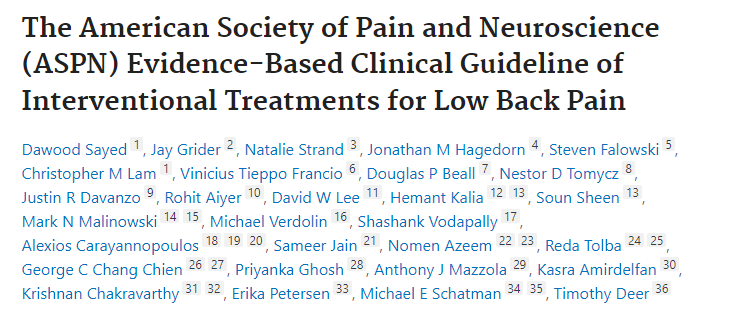
- The highest-level trial of the permanently implanted PNS system was an international, multi-center, prospective, randomized, active, sham controlled, blinded trial, which generated high, level I-A evidence supporting the significance of the treatment effect.
- The ReActiv8-B trial “demonstrated clinical effectiveness as measured by substantial and durable improvements in pain, disability, and quality of life in a cohort of patients with a favorable benefit risk profile.
- The rates of adverse events are consistent with known SAE rates for spinal cord stimulation therapy; however, there was no finding of lead migration.
- The ASPN Back Group recommends offering the permanently implanted PNS system given that there is high certainty that the net benefit is substantial.
Healthcare Economics
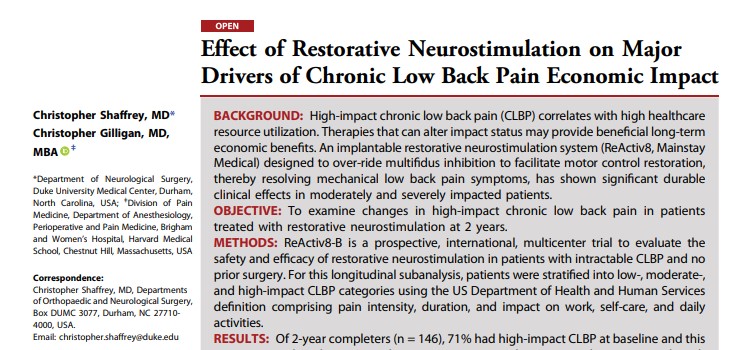
- In addition to clinically meaningful improvements in pain and function with long term durability, the overwhelming majority of patients transitioned from a high to a low-impact CLBP state.
- 71% of patients had High Impact pain at baseline that reduced to 10% at 2 years
- 85% of patients reported low-impact pain at 2 years
- This is typically associated with significantly lower direct and indirect healthcare utilization levels.
- The recovery trajectory is consistent with a restorative mechanism of action and suggests that over the long term these health states will be maintained.

